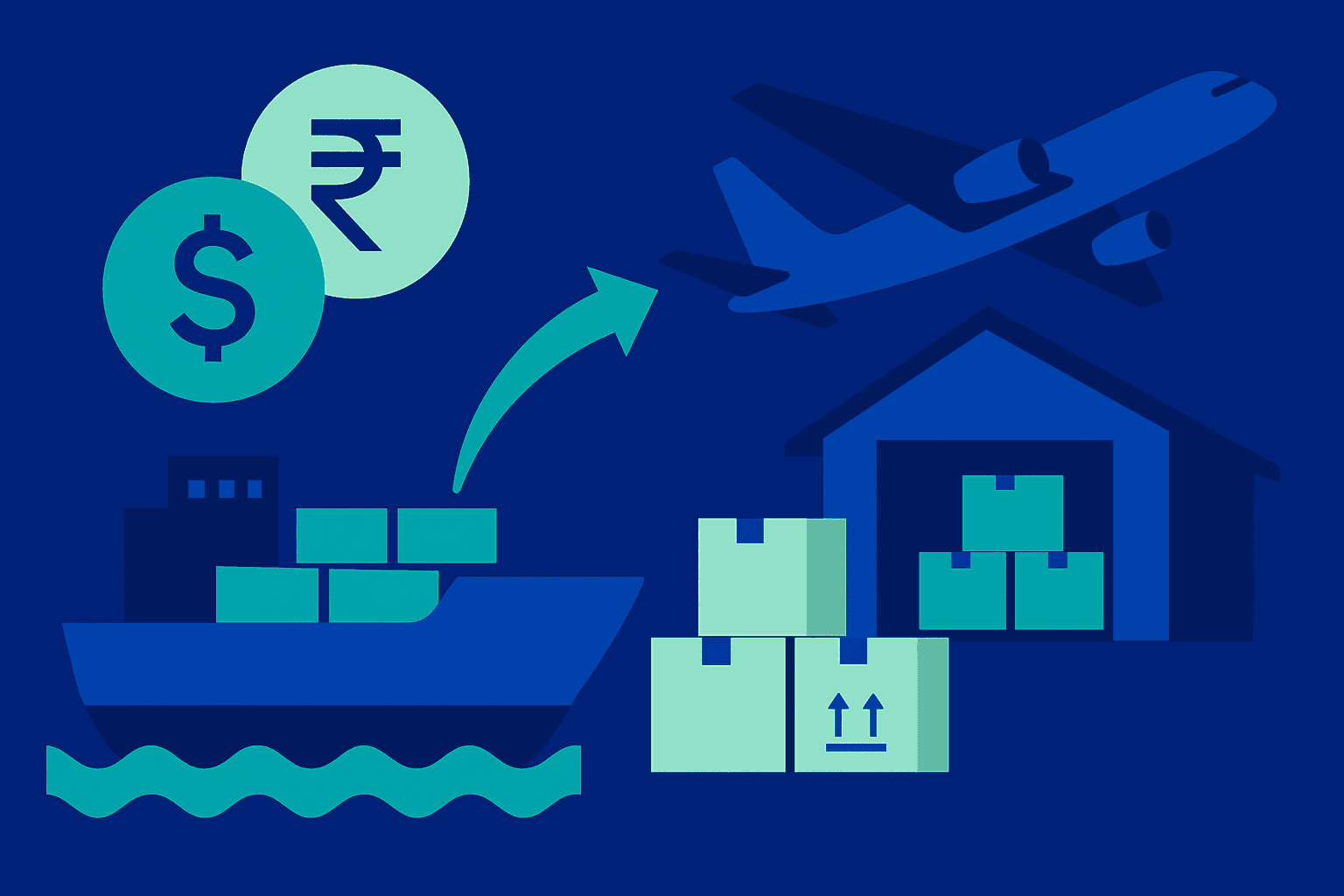Managing Foreign Exchange Risk: Protecting Your Profits in Global Business

Suppose you've just landed a $5,000 project from a US client. At today's exchange rate of ₹84 per dollar, you're expecting ₹4,20,000 in your account. However, by the time payment is actually received two weeks later, the rupee has strengthened to ₹81 per dollar. Now you're only getting ₹4,05,000 - that's ₹15,000 less for the same work.
This is foreign exchange risk in action. It's the potential loss you face when currency values shift between earning money and receiving it.
If you're a freelancer getting paid monthly in dollars, an exporter giving clients 30-day payment terms, or running a SaaS with international customers, these fluctuations can seriously impact your bottom line. What seemed like a profitable month can suddenly become a struggle to cover expenses, all because of currency movements beyond your control.
This article will show you practical ways to protect your income from currency fluctuations, so you can focus on growing your business instead of worrying about exchange rate swings.
Types of Foreign Exchange Risk
When dealing with international payments, you'll encounter three main types of foreign exchange risk. Each one affects your business differently, so understanding them helps you prepare better.
Transaction risk
Transaction risk is a common concern that most freelancers and small exporters face daily. This occurs when you agree to a price in a foreign currency, but exchange rates change before you receive payment. Say you're an Indian design agency that quotes $10,000 for a website project.
You send the invoice at a rate of ₹83 per dollar, expecting ₹8,30,000. But if the rupee strengthens to ₹81 per dollar by payment time, you only receive ₹8,10,000 - a loss of ₹20,000 for the same work. While currency movements could also work in your favour if the rupee weakens, the risk of loss is what keeps business owners awake at night.
Translation risk
Translation risk mainly affects larger businesses with international subsidiaries or assets in multiple currencies. When they convert foreign financial statements into their home currency for reporting, exchange rate fluctuations can significantly alter the appearance of their financial books.
For example, a company with a US subsidiary might report substantial dollar revenues on its local books, but when converted to rupees for Indian reporting, a strengthening rupee could make those same revenues appear much smaller. This creates accounting challenges where actual business performance stays the same, but financial reports tell different stories depending on currency movements.
While this type of risk doesn't impact day-to-day cash flow like transaction risk does, it can affect company valuations, investor perceptions, and loan eligibility based on financial ratios. This isn't usually a concern for most individual freelancers or exporters.
Economic risk
Economic risk is the long-term impact that currency trends have on your competitiveness. If the rupee continues to strengthen against the dollar, your services will become more expensive for US clients over time, potentially harming future business.
For instance, if you charge $50 per hour when the rate is ₹80 per dollar, you earn ₹4,000 hourly. But if the rupee strengthens to ₹75 per dollar over two years, that same $50 now only gives you ₹3,750 per hour - you're essentially earning less without changing your rates, or you need to raise prices and risk losing clients to competitors.
Why Indian Freelancers and Exporters Are Exposed
Indian businesses face unique challenges when it comes to foreign exchange risk, and many don't realize how much it's costing them until it's too late.
Most clients prefer their home currency.
Your international clients naturally want to pay in dollars, euros, or pounds. This makes sense for them, but it puts all the currency risk on your shoulders. Every invoice you send becomes a gamble on where exchange rates will be when payment arrives.
Banks charge hidden costs
Indian banks exacerbate the issue by charging hidden markups of 2-4% on top of already poor conversion rates. That $5,000 payment doesn't just lose value from rate fluctuations - you're also paying significant fees that eat into your margins without you even noticing.
Limited hedging options for small businesses
While large exporters can utilize forward contracts and other financial instruments to protect themselves through a process called hedging, where they lock in future exchange rates to avoid losses, freelancers and small agencies often lack access to these hedging tools. You're left to absorb whatever the market throws at you.
Delayed payments amplify the risk
That client who takes 45 days to pay instead of the agreed 15 days isn't just hurting your cash flow - they're giving exchange rates more time to move against you. The longer the gap between earning and receiving money, the more exposed you become to currency swings.
Foreign Exchange Risk Management Strategies
Now that you understand the risks, let's look at practical ways to protect your income from currency fluctuations.
Forward contracts
Lock in today's exchange rate for a future payment. If you're expecting $10,000 next month and today's rate is ₹84, you can secure that rate regardless of where the market moves. This works well for large exporters who can access bank forex desks, but most freelancers and small businesses don't qualify for these services or meet the minimum transaction amounts.
Smart invoice currency choices
This can help reduce your exposure. Consider adding a small buffer of 1-2% to your USD or EUR pricing to offset potential fluctuations. If you usually charge $5,000, pricing it at $5,100 gives you some cushion against adverse rate movements. You're building in a small insurance premium.
Consider EEFC (Exchange Earners' Foreign Currency) Account
EEFC accounts let you hold foreign currency and choose when to convert. This gives you flexibility to wait for better rates, but it also means you're still carrying the risk. You might hold dollars hoping for a better rate, only to watch it drop further. Further, you can't hold funds in your EEFc account indefinitely; you need to convert it by the last day of the next calendar month after the funds are credited.
Transparent FX platforms
Platforms like Skydo provide real-time, no-markup exchange rates, ensuring you receive the full value of your earnings. While you can't always control the timing of conversions, you can at least avoid the hidden costs that traditional banks add to your transactions.
How to Track and Time Currency Conversion
While you can't predict exchange rates perfectly, smart timing and tracking can help you make better conversion decisions.
Use reliable rate references to understand the real market value
RBI reference rates and mid-market rates provide a true picture, without bank markups. These rates help you spot when banks are charging excessive spreads on your conversions. Most currency tracking apps and financial websites show these benchmark rates for free.
Avoid weekend and holiday settlements whenever possible
Currency markets are closed during these periods, so banks often use outdated rates or add extra margins to cover their risk. If you receive payment on Friday evening, consider waiting until Monday to convert unless you urgently need the funds. This only works if you have the option to withhold conversion - like with an EEFC account, where you can hold foreign currency - rather than automatic bank conversions that happen immediately upon receipt.
Stay aware of central bank announcements that can significantly impact the rupee
RBI interest rate decisions, policy changes, or major economic announcements often cause immediate currency movements. Following basic economic news helps you anticipate when rates might shift.
Set up conversion alerts to catch favorable movements
Many currency apps let you set notifications when the rupee weakens against the dollar. If you're holding dollars and get an alert that rates have moved in your favor, you can convert quickly. Even a difference of ₹1 per dollar on a $5,000 payment means ₹5,000 more in your account.
Real Example: INR vs USD Volatility
Let's look at actual numbers to see how much currency fluctuations can cost you. In 2023, the USD-INR exchange rate fluctuated between ₹81.5 and ₹83.6, representing a difference of over ₹2 per dollar.
This might not sound like much, but the impact on your earnings is significant. If you received a $10,000 payment when the rate was at its peak of ₹83.6, you'd get ₹8,36,000. The same payment at the year's low of ₹81.5 would only give you ₹8,15,000. That's a difference of ₹21,000 on a single payment - enough to cover your monthly expenses or invest in new equipment.
Many businesses overlook this margin loss entirely.
They focus on winning clients and delivering projects, but fail to realize that currency movements are quietly reducing their profits. A freelancer earning $5,000 monthly could see their annual income vary by over ₹1,00,000 just based on conversion timing, without doing any more or less work.
The volatility isn't going anywhere. Political events, economic policies, and global market conditions will continue to cause these swings. The businesses that acknowledge this reality and plan for it will consistently outperform those who leave it to chance.
Turn Forex Risk into a Strategic Advantage
You'll never eliminate foreign exchange risk, but you can manage it wisely and prevent currency fluctuations from quietly eroding your profits.
The key is being intentional about how you handle foreign currency, rather than leaving everything to chance. Multi-currency accounts give you more control over conversion timing, letting you wait for better rates. Modern platforms can eliminate hidden costs that traditional banks love to bury in their rates.
Skydo specifically addresses these challenges by offering live market rates with zero markup and faster settlements that reduce your exposure time. Unlike traditional banks that add 2-4% hidden fees, Skydo shows you exactly what you're paying upfront. You get global bank accounts instantly, real-time payment tracking, and transparent pricing that helps you keep more of what you earn. When you know exactly what you're paying and receiving, you can make better decisions about your business finances.
The businesses that treat currency management as a strategic part of their operations consistently outperform those who ignore it. With Skydo's transparent approach, you can finally see where your money is going and take control of your international payments.
Try Skydo for transparent international payments that put you in control.
What is foreign exchange risk in international business?
Foreign exchange risk is the potential financial loss caused by currency fluctuations between the time you earn money in a foreign currency and when you actually receive or convert it. For example, a $5,000 project quoted at ₹84/USD could lose value if the rupee strengthens to ₹81/USD before payment.
Why are Indian freelancers and exporters more exposed to forex risk?
What are the main types of foreign exchange risk?
How can small businesses and freelancers manage forex risk?
How does Skydo help reduce foreign exchange risk?












